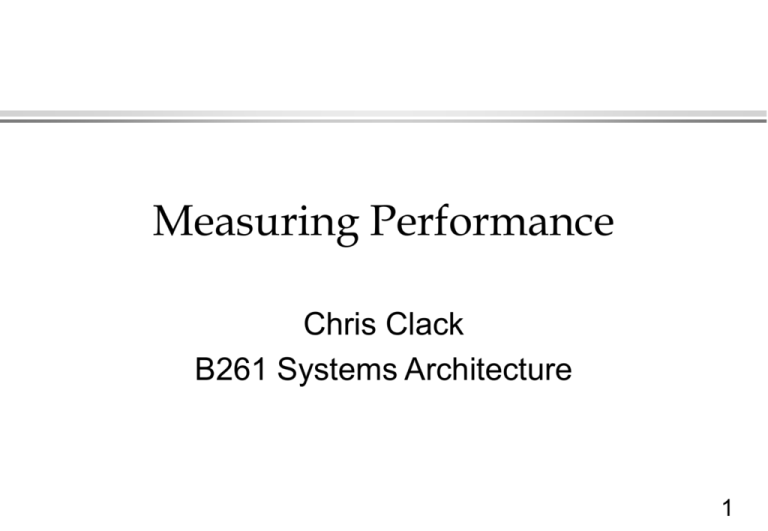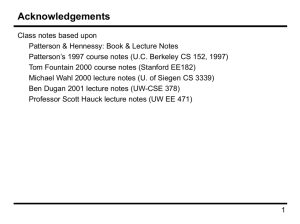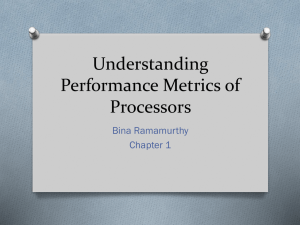lecture2 - UCL Computer Science
advertisement

Measuring Performance Chris Clack B261 Systems Architecture 1 Outline • • • • • Why measure performance? Characterising performance Performance and speed Basic terminology for measuring Performance and Execution Time 2 Why Measure Performance? SO THAT YOU KNOW WHAT YOU’RE SUPPOSED TO BE GETTING! So that you can compare systems! So that you can know if the machine can do its tasks. 3 Characterising Performance • Not always obvious how to characterise performance: • • • • motor cars football teams tennis players computers? • Can lead to serious errors • improve the processor to improve speed? 4 Performance and Speed • Performance for a program on a particular machine • 1 E x e c u tio n ( X ) P e r fo r m a n c e ( X ) E x e c u tio n (Y ) n P e r fo r m a n c e (Y ) E x e c u tio n ( X ) P e r fo r m a n c e ( X ) • X is n times faster than Y 5 Measuring Time • Execution time is the amount of time it takes the program to execute in seconds. • Time (computers do several tasks!) • elapsed time based on a normal clock; • CPU time is time spent executing this program • excluding waiting for I/O, or other programs 6 Execution Time Elapsed Time (real time) CPU time for this program I/O waiting & other programs Example (UNIX) 11.099u 8.659s 10:43.67 3.0% user (direct) system (time in OS) (user) (seconds) (system) (elapsed) (seconds) (min:secs) CPU time = 3.0% of elapsed time 7 Measuring Amounts • • • • • • • 1 bit 8 bits = 1 byte 1024bytes = 1 kilobyte = 1KByte = 1K = 210 1024KBytes = 1 megabyte = 1MB = 220 1024MB = 1 gigabyte = 1GB = 230 1024GB = 1 terrabyte = 240 and on to infinity Aside - 1 decade ago my home computer had 32K memory. Today it has 32MB, and needs to be upgraded to at least 64MB! 8 Measuring Times • Duration • • • • 1 second 1/1000 second = 1 millisec = 1ms = 10-3 s 1/1,000,000 s = 1 microsec = 10-6 s 1/1,000,000,000s = 1 nanosec = 10-9 s • Frequency • 1 Herz = 1 cycle per second • 1 MHz = 1,000,000 cycles per sec • 100MHz = 100,000,000 cycles per sec. 9 Computer Clock Times • Computers run according to a clock that runs at a steady rate • The time interval is called a clock cycle (eg, 10ns). • The clock rate is the reciprocal of clock cycle - a frequency, how many cycles per sec (eg, 100MHz). • 10 ns = 1/100,000,000 (clock cycle), same as:• 1/10ns = 100,000,000 = 100MHz (clock rate). 10 Purchasing Decision • Computer A has a 100MHz processor • Computer B has a 300MHz processor • So, B is faster, right? •WRONG! • Now, let’s get it right….. 11 Measuring Performance • The only important question: “HOW FAST WILL MY PROGRAM RUN?” • CPU execution time for a program • = CPU clock cycles * cycle time • (= CPU clock cycles/Clock rate) • In computer design, trade-off between: • clock cycle time, and • number of cycles required for a program 12 Cycles Per Instruction • The execution time of a program clearly must depend on the number of instructions • but different instructions take different times • An expression that includes this is:• CPU clock cycles = N * CPI • N = number of instructions • CPI = average clock cycles per instruction 13 Example • Machine A • Machine B • clock cycle time • clock cycle time • 30ns/cycle • 10ns/cycle • CPI = 0.5 for prog X • CPI = 2.0 for prog X Let I = number of instructions in the program. CPU clock cycles (A) = I * 2.0 CPU time (A) = CPU clock cycles * clock cycle time = I * 2.0 * 10 = I * 20 ns CPU clock cycles (B) = I * 0.5 CPU time (B) = CPU clock cycles * clock cycle time = I * 0.5 * 30 = I * 15 ns P e r fo r m a n c e ( A ) P e r fo r m a n c e ( B ) E x e c u tio n ( B ) E x e c u tio n ( A ) 0 .7 5 14 Basic Performance Equation • CPU Time = I * CPI * T • I = number of instructions in program • CPI = average cycles per instruction • T = clock cycle time • CPU Time = I * CPI / R • R = 1/T the clock rate • T or R are usually published as performance measures for a processor • I requires special profiling software • CPI depends on many factors (including memory). 15 Other “tricks of the trade” • MIPS • Million Instructions Per Second • MFLOPS • Million Floating Point Operations Per Second • Benchmarks: SPECs • Average Performance over a set of example programs • Are any of these accurate? or even useful? 16 Marketing Metrics (Patterson) MIPS = Instruction Count / Time * 10^6 = Clock Rate / CPI * 10^6 •machines with different instruction sets ? •programs with different instruction mixes ? • dynamic frequency of instructions • uncorrelated with performance MFLOP/S = FP Operations / Time * 10^6 •machine dependent •often not where time is spent Amdahl's Law Speedup due to enhancement E: ExTime w/o E Speedup(E) = -------------------ExTime w/ E Performance w/ E = --------------------Performance w/o E Suppose that enhancement E accelerates a fraction F of the task by a factor S and the remainder of the task is unaffected then, ExTime(with E) = ((1-F) + F/S) X ExTime(without E) Speedup(with E) = ExTime(without E) ÷ ((1-F) + F/S) X ExTime(without E) Summary • Dealt with issues of measuring performance • Considered terminology for measuring performance • • • • • bits bytes megabytes nanoseconds MHz • Seen the basic formulae for execution time. 19









